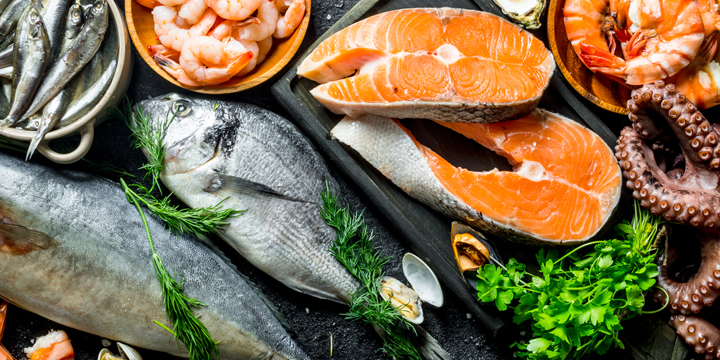
Seafood, which includes fish and shellfish, is delicious, easy to prepare and incredibly healthy for people with diabetes. Read on to get tips on what type of seafood is best to choose at the grocery store and why fish should be on your menu.
5 health benefits of seafood
Seafood has a lot of important health benefits, especially for people with diabetes.
- Seafood is an excellent source of protein. Eating foods rich in protein helps you feel fuller longer, which means you won’t feel hungry quickly after eating. They are also known to help increase muscle mass.
- Numerous studies have shown that people who eat seafood regularly are less likely to have heart disease than those who don’t. One large study of 40,000 men found that those who consumed one or more servings of fish per week had a 15% lower risk of heart disease.
- Seafood is an excellent source of Vitamin D, which helps build bones and keep them strong and healthy.

- Seafood is low in saturated fat (the “bad” fat). Including more fish in your weekly menu plan means that you are replacing it with other protein sources that may be higher in saturated fat (such as beef and pork), and therefore less healthy.
- Seafood is an excellent source of omega-3 fatty acids. These nutrients help build and maintain a healthy body. They also help keep your heart, lungs, blood vessels and immune system working properly.
What types of seafood should you eat?
Canada’s Food Guide recommends that people should eat a variety of seafood as part of a healthy eating plan. Some types of healthy fish and shellfish you can try include:
- Cod
- Haddock
- Halibut
- Herring
- Mackerel
- Shrimp
- Salmon
- Sardines
- Scallops
- Trout
- Tuna
Choose oily fish more often
Oily fish especially contain high amounts of omega-3 fatty acids, which are particularly good for you. Examples of oily fish from the list above include salmon, mackerel, sardines, herring, mussels, trout and oysters.
Exploring your options: fresh, frozen or canned seafood?
Whichever types of seafood you choose, the key is to find the ones you like, whether they’re fresh, frozen or canned.
If price is an issue, frozen or canned seafood is generally less expensive, but can be just as healthy as fresh options, if you keep a few key points in mind: check the Nutrition Facts table, and choose products with the lowest amounts of saturated fat and sodium.

Tips for buying fresh seafood
- Purchase fresh fish and shellfish the day you plan to cook it.
- Fresh fish should be firm, and the flesh should spring back when it is touched. The fish should have only a slightly salty or freshwater scent, and not a strong “fishy” smell.
- Avoid buying seafood that has been in the grocery store case for too long. Be sure to check the date that it was packaged.
Tips for buying frozen seafood
- Avoid breaded fish and fish with added sauces. These generally have added calories, sodium and saturated fat.
- Individually frozen fish fillets have the advantage of allowing you to defrost just what you need for one meal.
- Once thawed, avoid re-freezing fish; it should be cooked immediately.
Tips for buying canned seafood
- Canned seafood offers a quick and easy solution for on-the-go meals, or for those days when you’re just too busy to plan a meal.
- Remember that the health benefits of canned seafood are equal to those of fresh seafood, so don’t shy away from the many choices of canned seafood, such as tuna, salmon, oysters and herring.

- Canned options found in the grocery aisles are of good value, easy to find, can be kept on hand in the pantry, and the quality is always consistent. Be sure to stock up when they’re on sale!
- The sodium content of canned seafood can be reduced by rinsing and draining it before using.
The next time you’re at the grocery store, spend a few minutes exploring the seafood department and the shelves of canned fish. You’ll find heart-healthy choices that are not only delicious, convenient and quick to prepare, they’ll also reduce your consumption of other, less-healthy, proteins.


